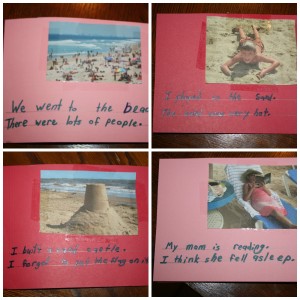In a previous blog I discussed 3 kinds of reading children need to participate in as they’re learning to read; 1) beautiful, language rich Read-Alouds, 2) challenging Read Togethers, and 3) easy Read Alones.
See the entire blog post here… http://www.meandtheestudios.com/meblog/right-book-really-matter/
In the same way, there are several kinds of writing that help young children build confidence in their early compositions. For all of the following ideas you can certainly use paper of any kind but I would encourage using old file folders, trimmed and cut in half, to produce “books” with your child. The production of “books” solidifies the idea that each of us is an “author” when we write down the stories from our life. My friend, Writing Really Does Matter!
Writing for your child – Your youngest writers will learn much about “concepts about print” from you as you write for them. Concepts about print include basic concepts like a letter verses a word, upper verses lower case letters, left to right directionality, the return sweep, top to bottom layout for text, punctuation, etc. When you write for your child, recording an activity from her life or some of her favorite things, you 1) validate her life as being important, 2) create readable text for her earliest reading attempts, and 3) have a valuable opportunity to talk through early print concepts. These are certainly necessary for both her reading and her writing development.
Writing with your child – When your child has many sounds and the corresponding letters fairly well mastered and is beginning to learn a handful of sight words (you might call them high frequency or high utility words), they are ready to “share the pen”. When you share the pen with your child, you write a good bit of the text yourself and encourage your child to add the parts they know. I’ve listed two examples below, but this activity can be used flexibly along the entire early reading and writing skill progression.
Your child might know the majority of consonant sounds and the corresponding letters. You might have him add the first letter for many of the words on the page. You might be writing about your pet and your child wants to add, “Oscar is big and fat.” You’ll mention that Oscar’s name starts with a capital letter, like all names, and then you’ll say “Oscar” aloud, stretching out the sounds as you write the letters. You’ll add the word “is”, stretching the sounds, and stop for the word “big”. You’ll say something like, “The next word is big (and make the b sound again). What do you hear at the beginning of “big”? Yes, the sound “b” and what letter makes that sound? Yes! The letter, “b”. I want you to add a “b” at the beginning of our next word “big”.” Let your child add the letter then take the pencil back from your child and you’ll add (while stretching to hear independent sounds) the “i” and “g” to finish “big”. You can write “and” (stretching [always stretching] the sounds) and follow the same process for “fat” that you worked through for “big”.
Your child might know the word “I” and almost know the word “like”. Create a book about some of his favorites and encourage him to write the words “I like” on every page. He can also probably add the period at the end of every sentence to help solidify the use of an end mark.
We certainly all have something to say, and early writing instruction helps a child see that his “voice” matters. In general, use your child’s choice of words to help him record his message. You’ll be tempted to edit his word choice, but he will likely remember (he has to remember to construct) his own structure and will struggle to remember yours.
Independent writing – When your child is writing most 2 consonant words independently you become the writing mentor. Your child will still enjoy writing her own books about her activities but she will be doing the planning, layout, and writing for herself. You are there as a mentor to offer suggestions and prompt when you notice a problem (CAUTION – Do not nit-pick. You want her to 1) feel confident and 2) have a product she will treasure. If you nit-pick she will not want to write with you acting as “mentor” and will likely never want to look at her creation again.)
The early writing activities go hand in hand with teaching a child to read. In fact, whatever new skill your child is working on in reading can be solidified in writing. Yes, you’ll have the opportunity to be creative in finding a book idea that incorporates the new skill. The dual approach makes the new reading skills and “concepts about print” come alive for young children who will all benefit from this hands-on approach to learning early literacy skills.
Happy writing!
Before you leave the site, follow my blog (top, right of this post). It’s quick and easy!
For more from Marea, check out Me and Thee Studios’ faith based leveled readers for 1st-2nd graders at http://www.meandtheestudios.com/early-reader-collection.html




